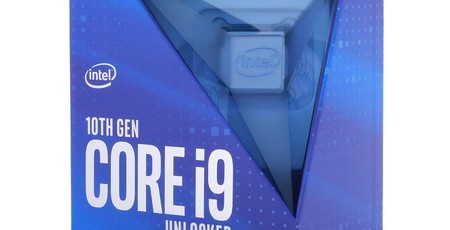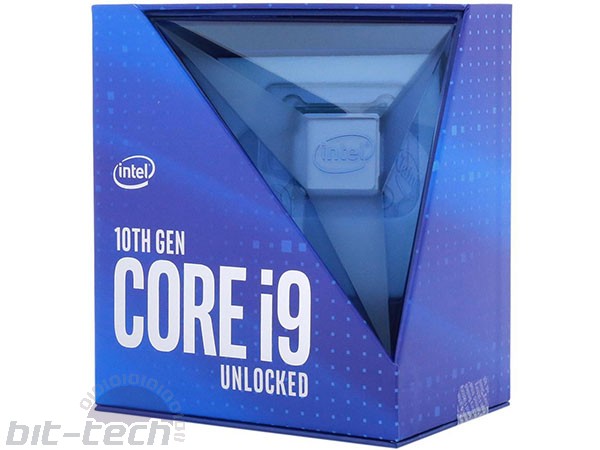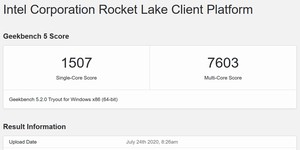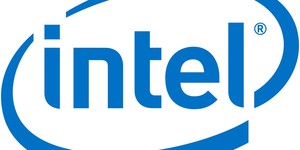
Manufacturer: Intel
UK price (as reviewed): £499 (inc. VAT)
US price (as reviewed): $488 (exc. tax)
Intel is today launching a wide range of 10th Gen Core processors that have previously been known by the Comet Lake S codename. Headline features over 9th Gen Core include more cores, higher frequencies, more cache, faster memory speeds, and hyperthreading across the entire portfolio.
The underlying architecture is ostensibly the same as 9th, which in turn can trace direct origins all the way back to the Skylake generation of 2015. Intel's well-documented problems in shifting on over to a space- and energy-saving 10nm process for the bulk of its chips forces 10th Gen desktop to persevere with a refined 14nm node.
Nevertheless, the new Core family makes a lot more sense from a core-and-thread count point of view, and compares well against current AMD competition.
| Model | Cores/Threads | Base Freq | Boost Freq | Smart Cache | TDP | Included cooler | SEP (USD) | Availability |
|---|---|---|---|---|---|---|---|---|
| Core i9-10900K | 10/20 | 3.7GHz | 5.2GHz | 20MB | 125W | No | $488 | May 20, 2020 |
| Core i7-10700K | 8/16 | 3.8GHz | 5.1GHz | 16MB | 125W | No | $374 | May 20, 2020 |
| Core i5-10600K | 6/12 | 4.1GHz | 4.8GHz | 12MB | 125W | No | $262 | May 20, 2020 |
| Core i5-10500 | 6/12 | 3.1GHz | 4.5GHz | 12MB | 65W | Yes | $192 | May 20, 2020 |
| Core i5-10400 | 6/12 | 2.9GHz | 4.3GHz | 12MB | 95W | Yes | $182 | May 20, 2020 |
| Core i3-10320 | 4/8 | 3.8GHz | 4.6GHz | 8MB | 65W | Yes | $154 | May 20, 2020 |
| Core i3-10300 | 4/8 | 3.7GHz | 4.4GHz | 8MB | 65W | Yes | $143 | May 20, 2020 |
| Core i3-10100 | 4/8 | 3.6GHz | 4.3GHz | 6MB | 65W | Yes | $122 | May 20, 2020 |
Core i9-10900K runs at 5.2GHz on up to two cores under Turbo Boost 3.0. All-core speed is also decent, at 4.8GHz. It can actually run at 5.3GHz/4.9GHz for those two parameters if temperature is kept below 70°C under a technology known as Thermal Velocity Boost. It's this heightened frequency that allows Intel to proclaim 10th Gen Core as the world's fastest gaming chips.

Pricing is roughly in-line with the same model numbers from the previous generation. This ought to mean a nice uptick in performance without having to shell out more cash. That would be the case if these processors ran on the LGA1151v2 form factor and Z390 chipset that most enthusiasts are familiar with. Intel, however, chooses this juncture to move 10th Gen Core to 400-series chipsets harnessing an LGA1200 socket. If it's not clear, these processors need a brand-new motherboard, too, and they are not backwards-compatible with 9th Gen, or earlier, models. That is the price for adopting new technology this time around.
A couple more points to mention. Intel also increases the TDP, or power, of the premier processors, with the unlocked K-series from the Core i9, i7, and i5 families now consuming up to 125W, up from 95W. There are other models in the various ranges, suffixed with either F (no graphics) or T (35W, low-power), but it seems strange that the bulk are offered in only 65W or 125W parts - one ought to expect 95W chips somewhere. Intel carries over Turbo Boost 3.0 to Core i7 but removes Thermal Velocity Boost. Both Core i7 and i9 receive memory-frequency upgrades, to 2,933MHz, though the remainder of 10th Gen is stuck on DDR4-2,666MHz.
Core i9-10900K is definitely going to be faster than Core i9-9900K in every meaningful scenario thanks to its extra number of cores and higher peak frequencies. The question for those looking at a premier CPU for that next build is whether Intel, already top dog in gaming, has done enough to go toe-to-toe against the AMD Ryzen 9 processors that, on paper, still have even more muscle, particularly for rendering applications.

MSI MPG Velox 100R Chassis Review
October 14 2021 | 15:04








Want to comment? Please log in.